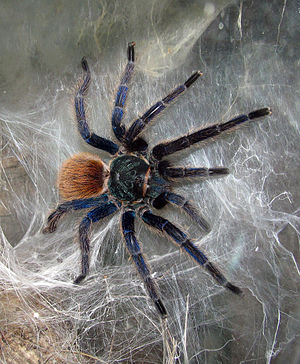Chromatopelma cyaneopubescens
| Chromatopelma cyaneopubescens | ||||||||||||
|---|---|---|---|---|---|---|---|---|---|---|---|---|

Chromatopelma cyaneopubescens , female |
||||||||||||
| Systematics | ||||||||||||
|
||||||||||||
| Scientific name of the genus | ||||||||||||
| Chromatopelma | ||||||||||||
| Schmidt , 1995 | ||||||||||||
| Scientific name of the species | ||||||||||||
| Chromatopelma cyaneopubescens | ||||||||||||
| ( Strand , 1907) |
Chromatopelma cyaneopubescens , sometimes also known as the cyan-blue Venezuela tarantula or just the cyan-blue tarantula , is the only species in the genus Chromatopelma . It is native to the region north of Coro in Venezuela . In recent years it has become popular with terrarium keepers and has been bred regularly.
features

Chromatopelma cyaneopubescens has a metallic blue to greenish shiny carapace , an opisthosoma covered with long, orange hair and bright blue legs. Young animals have a conspicuous black markings on the opisthosoma, but this disappears over time. Nymphs are colored differently: They have a wasp-like pattern on the opisthosoma and their legs are black up to the thigh . Patella to metatarsus are beige in color and the tarsus finally dark gray. The carapace has a golden sheen.
Females are on average between 6.5 cm and 7.2 cm long (measured from the biting claws to the spinnerets ). Males are on average between 3.5 cm and 4.3 cm long, although there can also be males that reach approximately the same size as small females.
distribution and habitat
Chromatopelma cyaneopubescens occurs on the Paraguaná Peninsula in the northeast of the Venezuelan state of Falcón . There the spider lives in savannah forests , which are made up of low-growing trees populated by orchids and tillandsia . The ground is covered with opuntia and bromeliads . The climate is changeable and very hot with daily highs up to 39 ° C, there is a low humidity (29–34%). Between October and January the humidity is slightly higher. This is also the time when the animals reproduce. At night it cools down to 18 ° C and dew forms.
The tarantula builds large and extensive webs of living space in tree hollows, hollow cacti or between roots. They were also found in the wooden structures of huts. She primarily looks for the undergrowth of the trees as the basis for her web of living space. It shows no digging activity. Since it looks like a ground-dwelling species, but has a pronounced arboreal way of life, it was described as Avicularia in 1907 .
The habitats of this species are often overgrazed by domestic goats . The goats eat everything that can be reached from the trees and near the ground, so that the landscape becomes stepped and is no longer suitable for the ecological demands of the tarantula. As a result, the government in Venezuela set up protected areas to protect them from destruction as a biosphere reserve.
In nature, the animals are exposed to high pressure from climatic conditions (long dry phases reduce the food supply) and are therefore on average not as old and large as in terrarium care.
defense
It is considered a calm to slightly defensive spider towards humans. Not yet fully grown spiders show anxious to nervous behavior in that they snap back into their nest with the slightest vibration. The young spiders are also good climbers. They move quickly and are reminiscent of Avicularia species.
This tarantula is a so-called " bombardier spider " and has stinging hairs on the opisthosoma , which it can use for defense by brushing it off with its hind legs and hurling it away. This hair is also used when mammals want to stick their noses into the spider's web of living space. However, the spiders seldom use their abdominal stinging hairs and threaten the alleged attacker by hitting their front legs. They flee when possible.
They are less threatened by animal predators than by the destruction of their habitat by the hoof kicks of mammals such as goats or tapirs . Another threat are parasitic nematodes or parasitic wasps .
Systematics
The name is a combination of Latin and ancient Greek words: "chroma" is Greek and means "color", "pelma" is Latin and means "sole", "cyaneos" is Greek and means "dark blue" and "pubescens" is Latin and means "hairy".
This spider species has already been assigned to several genera in the system. She first described Embrik Strand in 1907 as Eurypelma cyaneopubescens . A few years later it was added to the genus Delopelma by Alexander Petrunkevitch . Since the Delopelma species (today Aphonopelma ) are burrowing tarantulas and therefore have anatomical features that this spider species lacks, Günter Schmidt placed it in the monotypical genus Chromatopelma in 1995 .
literature
- Faulstich, J. (2011): Breeding report of Chromatopelma cyaneopubescens (Strand, 1907). Arachne, 16 (5): pp. 8-9.
- Martini, S. (2007): Chromatopelma cyaneopubescens (Strand, 1907) - Species description, keeping and breeding (Araneae: Theraphosidae: Theraphosinae). Arachne, 12 (5): pp. 11-18.
- Striffler, B. & Weinmann, D. (2003): Tarantulas in Venezuela from the Caribbean to the Tepuis. Draco, 4 (16): pp. 70-76.
Web links
Chromatopelma in the World Spider Catalog Chromatopelma cyaneopubescens in the World Spider Catalog
Individual evidence
- ↑ Natural History Museum of the Burgergemeinde Bern: World Spider Catalog Version 17.0 - Chromatopelma cyaneopubescens . Retrieved July 5, 2016.
- ↑ a b c d e f g h Stephan Martini: Chromatopelma cyaneopubescens - Species description, keeping and breeding. In: Arachne, Volume 12, Issue 5, September 2007 of the German Arachnological Society. V., ISSN 1613-2688
- ↑ a b c d Peter Klaas: tarantulas: origin, care, species . Eugen Ulmer Verlag, Stuttgart 2003/2007 ISBN 978-3-8001-4660-4


